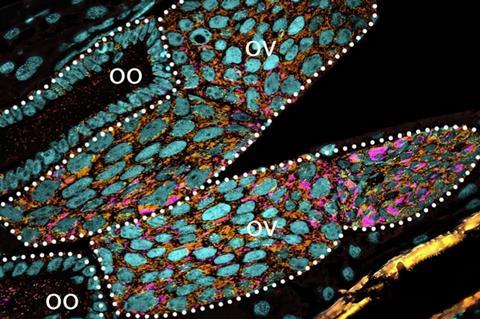The endosymbiont Symbiodolus clandestinus, which lives inside the cells of insects, has remained undiscovered by researchers until now.
Scientists at the Max Planck Institute for Chemical Ecology now report for the first time the discovery of Symbiodolus, which is found in at least six different insect orders. Using fluorescence in situ hybridisation, the researchers were able to show that Symbiodolus is present in all life stages and tissues of infected insects.

The symbiont is particularly abundant in the reproductive organs of adult females, as well as in eggs and larvae, suggesting that it is transmitted transovarially to the next generation. The interactions of the newly discovered bacterial symbiont with its host insects are not yet understood, but Symbiodolus is likely to have a considerable impact on insect communities and thus on ecosystems.
Exchange of services
Living organisms are always part of an ecosystem and are influenced by other living organisms. There are harmful interactions, such as when a parasite deprives its host of important resources, but there are also symbioses in which both partners benefit from the exchange of important services. The boundaries between parasitism and symbiosis are often blurred.
A team of researchers led by Martin Kaltenpoth, head of the Department of Insect Symbiosis at the Max Planck Institute for Chemical Ecology, has now described for the first time the newly discovered insect symbiont Symbiodolus clandestinus.
“Several members of our research group independently discovered Symbiodolus in different insect species. Through the lively exchange in our group and research in DNA databases, I realized that we were on the trail of a bacterial symbiont that is widespread in different insect species. Although it has been found from time to time, it has never been analyzed in detail. This is probably because the symbiont does not appear to have a clear effect on the hosts, and also because it is not always found in large numbers in the host. As a result, it seems to have escaped research until now,” explains first author Jürgen Wierz.
Genome sequencing
The doctoral researcher therefore wanted to find out more about the symbiont, in particular how widespread it is, in which insect tissues it occurs, and what interactions it has with the insects it colonizes. Using genome sequencing, the research team was able to identify Symbiodolus in 23 studied insect species from six different insect orders, including beetles, dipterans, butterflies and fleas. In the species with Symbiodolus, almost all of the analyzed individuals carried the symbiont, although the amount of Symbiodolus bacteria in the individual insect species varied greatly. This indicates that the symbiont is very well adapted to life in insects.
Using fluorescence in situ hybridization, an imaging technique based on the principle of complementary base pairing and fluorescent labelling, the researchers discovered that Symbiodolus can spread and invade cells in different insect tissues. The researchers found a particularly high number of Symbiodolus bacteria in the insects’ reproductive organs. They also found the symbiont in all life stages of the insects, including eggs, suggesting that the symbiont is transmitted from parents to offspring.
Host interactions
To learn more about possible interactions between symbionts and their host insects, the research team used genome sequencing to identify the secretion systems of Symbiodolus bacteria. Secretion systems help bacteria to efficiently transport molecules out of the cell and sometimes into a host cell or another microorganism, thereby controlling various biological processes. There are different types of secretion systems, each of which is suitable for specific tasks.
The team found several such secretion systems, including the three types, T1SS, T3SS and T6SS, as well as another, T4SS, which was only present in some of the insect genomes analyzed.
“It is impressive how many secretion systems the symbiont has, and we suspect that they play an important role in Symbiodolus’ ability to colonize different hosts and penetrate their cells,” says Jürgen Wierz. In addition to these interaction machineries, Symbiodolus can produce several amino acids and vitamins that could potentially be provided to its hosts and thus the symbiont might have a beneficial effect on the host. At the same time, several metabolic pathways have probably been lost during co-evolution with insects. It is therefore likely that the bacterium is dependent on its host for nutrients.
Symbiotic relationships
Although the interactions between the symbiont and its host are not yet fully understood, Symbiodolus has the potential to provide valuable insights into the nature of symbiotic relationships between insects and bacteria.
“If we can show how Symbiodolus evades its host’s immune system, invades cells and is transmitted to offspring, and compare these strategies with those of other bacteria, we can better understand how bacteria can form lasting partnerships with insects,” explains Martin Kaltenpoth, leader of the study.
“This would be an important step towards understanding the evolutionary origins and success of symbioses between insects and microorganisms, and how these symbioses could become such a successful strategy in nature.”




No comments yet